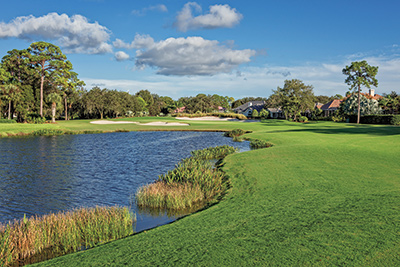Giving new life to an old bird

Only bermudagrass can be found on the Heron. Celebration was installed on the tees, fairways and rough, and Tifeagle on the greens. Tifgrand was picked for the chipping areas because it can be cut short to create a firm and fast surface, and support the bump and run style of play.
A needed update on the Heron Course, along with some creative communications, makes this course soar above its counterpart at the Oaks Club in Florida.
Before reconstruction work began at The Oaks Club, Osprey, Fla., architect Jason Straka of Fry/Straka Global Golf Course Design was playing a round on the club’s Heron course with Director of Golf Tim Beckwith. On one hole, Straka’s shot rested in front of a greenside bunker, and he had to contend with water on the other side of the green. He struck the ball and made a “pretty good” lob onto the green, which provoked a response from Beckwith.
“He looked at me and said, ‘I want you to remember something,’” Straka recalls. “‘Over 90 percent of our members do not have the physical skill or strength to hit that kind of shot.’ That moment stuck with me, and the project evolved into not so much designing the best golf course I possibly could, it became a much more targeted design.”
New beginnings
Straka first got involved with the renovation project in 2012, but it took multiple years of planning and obtaining permits before construction began. The Heron Course is one of two 18-hole courses at the Oaks Club. A look at the tee sheet before the renovation showed a majority of the rounds were being played on its counterpart, the Eagle Course.
The Heron opened in the 1980s and received some updates in the early 2000s, but as Beckwith told Straka, its design didn’t match its current members’ abilities. It forced them to play an aerial game down narrow fairways lined with too many trees onto built-up greens complexes that were surrounded by large chipping areas. There were also issues present below the turf, including an aging irrigation system and “horrific” drainage, according to Straka.
In this chicken-or-the-egg scenario, the Heron was built first, and the present-day housing development gradually surrounded the course. The course’s fairways initially were built up to allow for water to move off to the sides, but the housing plots lining the course were also raised up. This caused an issue for both the course and the homeowners.
“Essentially they created these huge swales between the golf course and the homes that couldn’t drain,” Straka says. “Summertime in particular, you can get several feet of sand and water for days on end, and the cart paths would be horrific.”
When it came time for construction in mid-2014, Straka’s renovation of the course was designed to make the Heron easier to maintain and play. A new wall-to-wall HDPE irrigation system was installed and the course was reshaped to direct water that used to sit between the course and the houses to catch basins or rivers.
To create more of a ground game, the plateaued greens were lowered and backstops added, and the surrounding greens complexes were given contours that lean up to greens.
“Better players are looking at these ground contours and they’re thinking they’ve got to bump and run it up these to get it to stop 2 to 3 feet from the hole,” Straka says. “Somebody that’s not that skilled can turn a little different angle on the same shot and hit it into the slope of a green to get it back into the middle of the green. Now, if they’re walking away with a bogey rather than a 7 or an 8, they’re thrilled.”
The course’s fairways were widened by removing trees to create more open shots for golfers. The 13th fairway sticks out in Straka’s mind. During construction he measured its width before taking members on a tour of the construction. It was only 10 yards wide at the time.
“I said to the folks, ‘We’re fortunate to work on a golf course called Erin Hills that is going to host the 2017 U.S. Open,’” Straka says. “I said, ‘Erin Hills doesn’t even have a fairway that is (only) 10 yards wide.’ You have to drive those points home, and those people are more accepting about widening these fairways to make it more reasonable.”
Frequent communication
Straka’s tours were frequent. His contract stated that he had to be on the course every week during construction, and he usually would stay for two days. Over the next year he racked up frequent flyer miles traveling from his office in Columbus, Ohio to Florida. When he arrived, it typically was Oaks Club Director of Green and Grounds Nick Kearns there to greet him and provide a ride to the site.
“Each visit there would be specific areas he would be focusing on, and after Jason would get the days’ project fine tuned he would ask my opinion to make sure I approved,” says Kearns, who began his current role in 2013. “We always wanted to make sure it was going to be best for both parties.”
There also was a third party, of course: the members. During his visits, Straka and Kearns would take a group of five to 30 members around the course. Some members consistently took the tours to keep an eye on the progress, while others would come every couple of months because they wanted to be surprised.
“I enjoyed giving the tours, I enjoyed the interaction and I think it keeps rumors down,” Straka says. “What would happen is we were building this huge network of supporters at the club.”
In the summer, more than half of the Oaks Club membership was unable able to attend the tours because they are “snowbirds,” traveling elsewhere to escape the Florida summer heat. To keep those members updated, the team of Straka and Kearns took to the sky with a drone.
Kearns would fly the course-owned drone over parts of the project under renovation to create a four- to five-minute video that was sent to the entire membership each week. The video included information such as the development of grading processes or bunker renovations.
“When we first start doing it, people didn’t really understand the concept, but the more I was able to show them that high view they normally wouldn’t see, they really appreciated it,” Kearns says. “There’s no way I could count how many times I heard how much they enjoyed seeing those videos, and it improved their trust in the project.”
Warm reception
The official opening of the renovated Heron was last November, and the results have yielded positive reviews from the membership. Straka has received multiple letters from members congratulating him on the project.
“I even got a personal letter from a former LPGA Tour player,” Straka says. “She said the renovation was exactly what the membership needed and that better players still find it to be challenging but all of the members find it to be extremely playable.”
According to Kearns, in the months following the renovation the amount of rounds played on the Heron course has started to soar.
“Jason continually told them that the course was going to be more playable. I think that’s probably one thing that they really didn’t comprehend when he was saying it,” Kearns says. “Now every time I see somebody or talk to somebody about their golf round on either golf course it never seems to fail — it comes back to something about the Heron.”
Photos: DAVE SANSOM
Editor’s note: Jason Straka designed the Oaks Club Heron course on behalf of Hurdzan/Fry Environmental Golf Course Design










